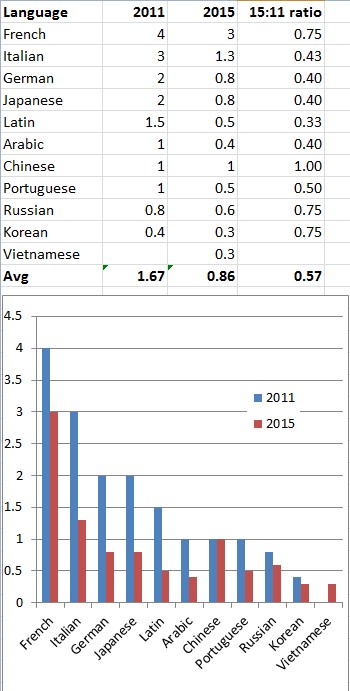November 25, 2015
What language is popular? A revisit
Four and half years ago, I checked language popularity based on the number of shelves for the foreign language books at a local Borders Bookstore here in south Texas. The result was as follows:
March 2011 at Borders
Spanish: too many
French: 4
Italian: 3
German, Japanese: 2
Latin: 1.5
Arabic, Chinese, Portuguese: 1
Russian: less than 1
Korean: less than 0.5
The Borders bookstore was closed down soon after that. Recently I went to a local Barnes and Noble store and checked the foreign language books just as I did before, and the result is:
November 2015 at Barnes and Nobles
Spanish 7
French 3
Italian 1.3
Chinese 1
German, Japanese 0.8
Russian 0.6
Latin, Portuguese 0.5
Arabic 0.4
Korean, Vietnamese 0.3
The following is a summary of the two sets of data (Spanish is excluded; the numbers less than 1 and 0.5 are artificially set to 0.8 and 0.4, respectively):

It's probably safe to assume that the two bookstores carry approximately the same total number of books. Then we see that either foreign language books are genuinely sold less in 2015 than in 2011, or the two stores have different focus, i.e., Barnes and Noble cares less about these language books than Borders.
But more interesting is the difference in change for specific languages. Of all that have data for both years (excluding Spanish), only Chinese has kept at the same level, taking one full bookshelf in both years. On average, the 2015-to-2011 ratio is 0.57. Relative to that, Chinese is way above average in books to be sold, and French, Russian and Korean are above average as well. The rest are attracting lower customer interest now than before, Portuguese > Italian > German = Japanese > Latin. Latin, with the biggest drop, occupies one-third of the space on the shelf after elapse of four and half years. There may be a shift of people's interest away from pure intellectual enjoyment to practical economic benefit.
This is of course a crude way to measure language popularity. Commercial bookstores such as Borders and Barnes and Noble make an effort to meet the demand of the market but there's no perfect, up-to-the-minute, match.
For completeness, here is another measurement of language popularity, based on an April 2014 poll of what language the language-loving people are studying conducted in the Polyglots group on Facebook, which had 16,000 members at the time. The popularity order,
French (935) > Spanish (807) > German (799) > English (651), Italian (448), ..., Mandarin+Chinese (360)
is obviously different from the bookstore popularity in 2011 or this year. For one, the stores are in Texas, where the presence of Spanish is particularly strong. Secondly, the market-determined popularity may differ from that in the Polyglots-poll because the latter is more of a reflection of the fun or leisure time enjoyment, not necessarily going along with the economic development in the region where a specific language is spoken; while studying Chinese may increase your chance to find a job in the global market, it may not be as much fun as studying the sexy Italian. It would be interesting, though, if the Polyglots group could conduct a poll every once in a while, so that we could see if the fun factor could also go up and down as the usefulness does. It probably will, but on a much smaller scale.